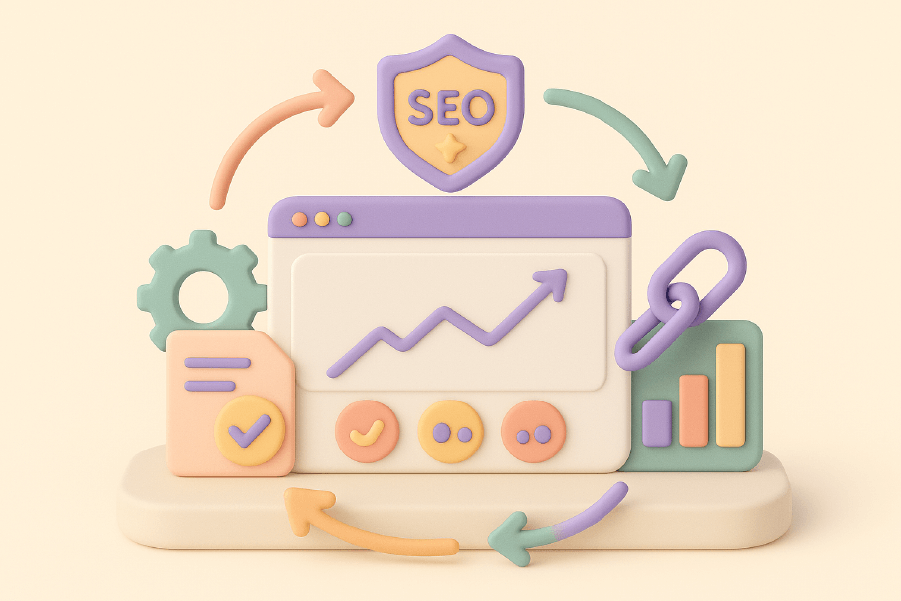
Envision a brand so strong it appears organically in search engine results. A brand that connects with your audience on a deeper level, earning their loyalty and trust. In today’s digital age, branding and SEO are not mutually exclusive, they’re best friends.
A well-designed brand identity attracts and engages customers, while also improving your SEO by increasing trust, dwell time, and organic traffic.
But what makes a brand great? The essential brand elements, such as adaptability, protectability, and strategic design, are crucial for creating a recognizable and memorable brand. How can you create a brand that users and search engines love? This article will cover the top branding elements for SEO-friendly brands, providing you with actionable tips to improve your online presence and dominate search engine results.
Every brand starts with defined brand identity elements. This includes your mission, values, and positioning. These elements impact your digital presence and online marketing.
Your brand mission and values should dictate every decision you make online. A brand promise is the unique value proposition a company presents to its target audience, defining the company’s mission and objectives.
By defining what your brand stands for, you’ll create a solid foundation that search engines and users love. When your brand mission and values are clear, you’ll attract the right audience and create content that’s relevant to your audience. This aligns your keywords, messaging, and overall brand strategy.
Your brand positioning is what sets you apart from the competition. It’s how you want to be remembered and what makes you unique. Effective brand positioning influences brand perception, helping your business stand out in a competitive market.
Successful brands use keywords to define their positioning. This ensures every touchpoint and interaction is optimized for search.
Think of positioning like your brand’s personality. It’s how you want to be seen and what makes you unique. For example, if you’re a chiropractor, instead of using generic keywords like “back pain relief”, you could optimize your positioning for long-tail keywords like “natural upper middle back pain relief from chiropractic care”. This way, every page, post, and interaction is optimized for search.
A brand name is a critical component of a company’s brand identity, and its impact on SEO should not be underestimated. A memorable and well-crafted brand name can significantly improve a company’s online visibility and search engine rankings.
Here are some key considerations for creating a brand name that is both memorable and SEO-friendly:

Keyword Inclusion:
Incorporating relevant keywords into your brand name can help improve your search engine rankings. However, be cautious not to make your brand name too generic or spammy.
For instance, a brand name like “EcoClean Solutions” subtly includes the keyword “clean” while maintaining uniqueness.

Uniqueness:
A unique brand name can help you stand out from the competition and improve your brand’s memorability. Conduct thorough research to ensure your brand name is not already in use by another company.
A unique name like “Zappos” is distinctive and memorable, setting the brand apart in the crowded e-commerce space.

Length and Simplicity:
A short and simple brand name is easier to remember and can improve your brand’s SEO. Aim for a brand name that is no more than two words and is easy to spell. Names like “Apple” and “Google” are prime examples of simplicity and memorability.

Brand Name Extension:
Consider registering variations of your brand name, including different extensions (e.g., .com, .net, .io), to protect your brand’s online presence and prevent cybersquatting. This ensures that your brand remains accessible and protected across various domains.
By carefully crafting a memorable and SEO-friendly brand name, you can establish a strong foundation for your brand’s online presence and improve your search engine rankings. A well-chosen brand name not only enhances your brand identity but also boosts your visibility in search results.

Your brand’s personality, voice, and messaging are what users experience online. A strong brand voice and messaging strategy ensure a consistent tone and theme across every touchpoint and interaction. This engages users and helps them quickly recognize your brand.
A consistent brand voice also improves SEO by giving you a unique tone that differentiates you from the competition.
A consistent brand voice makes it easier for users to find and engage with your content. This improves metrics like dwell time, which can positively impact your SEO. Whether your brand voice is formal, casual, or technical, it should match your audience’s expectations.
Your brand messaging should echo your SEO keywords. When you target the right keywords, you’ll naturally rank and attract the audience that matters to your business. To infuse your messaging with SEO keywords, focus on topics and themes that align with your brand messaging. Use tools like Google Keyword Planner or SEMrush to find keywords that relate to your message.
Taglines and slogans are essential branding elements that can help communicate a company’s value proposition and unique selling point. A well-crafted tagline or slogan can be a powerful tool for building brand awareness and differentiating your company from the competition.
Here are some key considerations for crafting concise and impactful brand messages:

Keep it Simple:
A simple and concise tagline or slogan is easier to remember and can be more effective than a lengthy or complex one. For example, Nike’s “Just Do It” is short, memorable, and powerful.

Focus on Benefits:
Instead of listing features or attributes, focus on the benefits that your product or service provides to customers. A tagline like M&M’s “Melts in your mouth, not in your hands” clearly communicates a benefit that resonates with consumers.

Emotional Connection:
Create an emotional connection with your target audience by using language that resonates with their values, needs, and desires. De Beers’ “A Diamond is Forever” evokes a sense of timelessness and emotional value.

Uniqueness:
Avoid using generic or clichéd taglines or slogans that could apply to any company. Instead, create a unique message that reflects your brand’s personality and values. A unique tagline like L’Oréal’s “Because You’re Worth It” speaks directly to the consumer’s self-worth and individuality.
By crafting concise and impactful taglines and slogans, you can effectively communicate your brand’s value proposition and create a memorable brand identity. These essential branding elements help differentiate your brand and build a strong connection with your target audience.

Your visual identity is more than just aesthetics; it encompasses every brand element, impacting how your brand appears in image search results and on social media.
A simple way to improve your image search engine results is by ensuring your logo is optimized. As a crucial part of your brand identity elements, a recognizable logo that includes your brand colors and key elements aligned with your brand keywords will help your brand appear in image search results.
When optimizing images, don’t forget to add alt text that includes keywords related to your brand and offerings.
The color palette of your brand not only defines its identity but also influences how users interact and engage with your content. Colors evoke emotions; some can create calmness, while others stimulate excitement or even anxiety.
For example, greens and earthy tones might resonate well with a landscaping business, symbolizing growth and natural beauty, while cooler shades like blues and grays can instill trust and professionalism, ideal for financial services.
Choosing the right color palette can help your brand communicate effectively with your target audience and align with the emotional tone you wish to convey.
Moreover, color selection has practical implications for visibility and readability across devices, especially on mobile screens where dark text on light backgrounds tends to be easier to read than reversed text.
The color palette also indirectly supports SEO performance by enhancing user experience, which can lead to increased engagement, shares, and clicks—factors that positively influence search engine rankings.
While color choices alone don’t directly impact SEO, a cohesive, user-friendly design aids brand recognition and encourages engagement. For example, a palette with high contrast and clear visual hierarchy makes it easier for users to navigate and absorb information.
Tools are available to assess color compatibility with accessibility standards, helping ensure your palette is not only visually appealing but also accessible, supporting a wider audience and further strengthening your site’s performance.
The font you choose for your brand plays a key role in conveying personality, professionalism, and accessibility. A well-chosen font enhances brand identity by making your content easier to read and visually appealing, creating a consistent experience across digital and print media. When it comes to your website, typography is not just an aesthetic choice; it directly impacts user experience, legibility, and consequently, SEO.
Fonts with high readability, such as sans-serif fonts, perform better across a variety of screen sizes and devices, which is crucial in our mobile-first world.
Legible typography minimizes user friction, reduces bounce rates, and can increase time spent on site—factors that indirectly contribute to SEO rankings. Additionally, selecting web-safe fonts that load quickly improves page speed, a critical element in SEO.
A consistent font across all brand touchpoints aids in brand recognition and reinforces trust. However, readability and loading speed aren’t the only aspects to consider.
Tools are available to assess the accessibility of your chosen fonts and ensure they meet readability standards. With accessible, SEO-friendly typography, your brand will appear more polished and user-focused, helping attract and retain more visitors.

Your website is the most critical component of an SEO-friendly branded website. How you layout your content and create a navigation and information architecture impacts SEO.
Good user experience is essential for SEO and a well-designed navigation system makes your site more user friendly. A clear site hierarchy is also important for SEO.
Creating a logical architecture and using a linking structure to connect sections and pages can improve indexation and overall visibility.
Your brand content layout is just as important as your navigation. A well-designed layout using a system of headings (H1, H2, H3, etc.) makes content more readable and scannable.
This is especially important for SEO as it allows you to optimise and structure your content with keywords in key header elements.
Fast loading pages are essential for user experience and search engines prefer them. Reducing load time will improve user experience and ensure your brand’s website is accessible on mobile and desktop.
A fast website is a critical SEO technical factor and should be addressed with image compression, caching, and minimising scripts.

Content marketing is the most effective way to tell brand stories and achieve SEO. It’s the only marketing tactic that allows you to fully showcase your brand personality, values and mission in a way that resonates with your audience.
When done right, content marketing can drive organic traffic and establish your brand as an authority in your industry.
Your blog is the most critical piece of your content marketing strategy. It’s where you can showcase your brand personality and tell stories that resonate with your audience. Optimising blog content for SEO is important for driving organic traffic and establishing your brand as an authority in your industry.
Visual content and marketing materials are critical for engaging your audience and improving SEO. Infographics and video not only share brand information in a unique way but also increase dwell time and engagement.
Your brand’s images are some of the most shared pieces of content and optimizing alt text with brand-specific keywords is a simple way to improve your searchability in image search engines like Google Image Search.

A strong brand identity is not just about visual elements; it’s also about creating an emotional connection with your target audience. Building a brand personality and emotional connection with your customers can help establish a loyal customer base and drive long-term growth.
Here are some key considerations for building a brand personality and emotional connection:

Brand Values:
Establish a clear set of brand values that reflect your company’s mission, vision, and personality. These values should guide all aspects of your branding and marketing efforts.
For example, Patagonia’s commitment to environmental sustainability is a core value that resonates deeply with its audience.

Brand Voice:
Develop a unique brand voice that reflects your brand’s personality and values. This voice should be consistent across all marketing channels and customer touchpoints.
Whether your brand voice is playful, authoritative, or compassionate, consistency is key to building a recognizable brand identity.

Emotional Storytelling:
Use emotional storytelling to create an emotional connection with your target audience. Share stories that reflect your brand’s values and personality, and highlight the benefits of your product or service.
Dove’s “Real Beauty” campaign is a prime example of using storytelling to connect emotionally with consumers.

Customer Experience:
Focus on creating a positive customer experience that reflects your brand’s personality and values. This includes everything from customer service to product design and packaging.
A brand like Apple excels in providing a seamless and enjoyable customer experience, reinforcing its brand identity at every touchpoint.
By building a strong brand personality and emotional connection with your target audience, you can establish a loyal customer base and drive long-term growth. Remember to stay true to your brand’s values and personality, and consistently communicate your unique value proposition across all marketing channels.
This approach will help you create a memorable brand identity that resonates with your audience and stands out in a crowded market.

When undertaking a rebranding initiative, it’s essential to incorporate all the tips provided for achieving an SEO-friendly brand that adapts to current digital needs. Rebranding offers an opportunity to refresh your brand identity while ensuring it aligns with modern SEO strategies and digital trends.
Brand guidelines are instrumental in maintaining a consistent brand image across all platforms, ensuring that the reimagined brand elements not only reflect the company’s values but also enhance its online presence.
Take, for instance, Nike’s brand identity. With its iconic slogan ‘Just do it’ and the recognizable ‘Swoosh’ logo, Nike exemplifies how a coherent vision and collaboration with athletes can inspire a global audience and enhance brand perception. These guidelines not only maintain consistency but also ensure that new branding elements are SEO-friendly, aligning with the company’s values and marketing strategies.
Our article, "Rebranding: Building a Strong Corporate Identity from Scratch", delves deeper into the importance of brand guidelines in creating a cohesive and memorable brand identity that resonates with your target audience and supports your SEO efforts.

Your brand is one of your most valuable assets, and creating an SEO-friendly brand is essential for establishing a strong business presence.
An SEO-friendly brand is both technical and strategic, focusing on crafting a website that search engines love and a brand that resonates deeply with your audience. It’s about developing a well-designed identity, utilizing messaging that connects, and creating content that captivates.
By integrating these essential branding elements, you’ll create a brand that stands out in a crowded market and garners the attention it truly deserves. Prioritizing these elements will help you build a brand that connects with your audience, earns credibility, and achieves visibility in a noisy digital landscape.
Book a call with our experts today and discover how we can help you achieve a memorable and impactful brand identity.
Let’s take the first step towards your brand’s success together!






Reach out to LIBRA 4 humans for expert guidance on tailor made SEO solutions.
Taking the first step often requires a leap of faith, and that's why we value these 30 minutes to understand the challenges your business faces.
Please complete a few questions so we can ensure our meeting is both efficient and productive.
Talk to you soon!